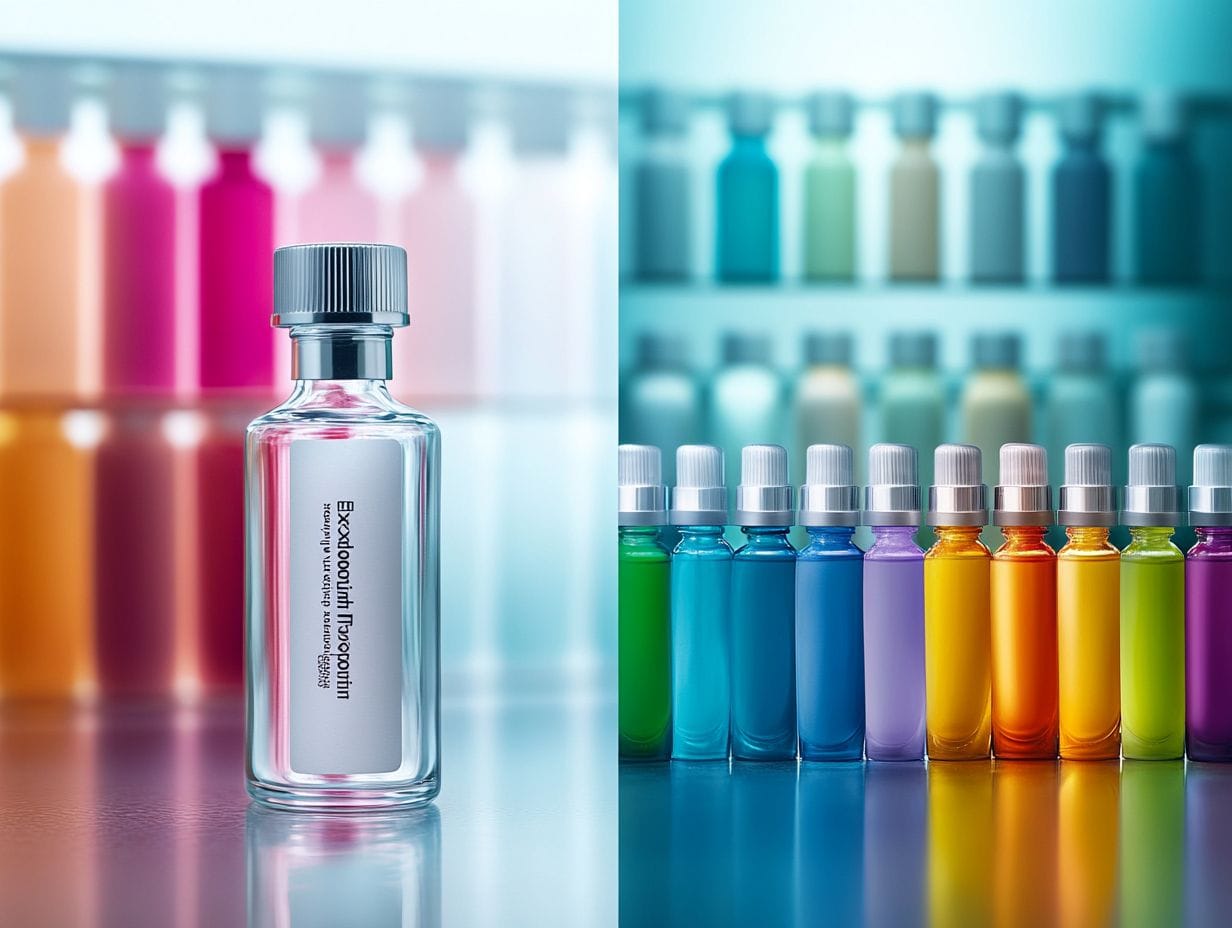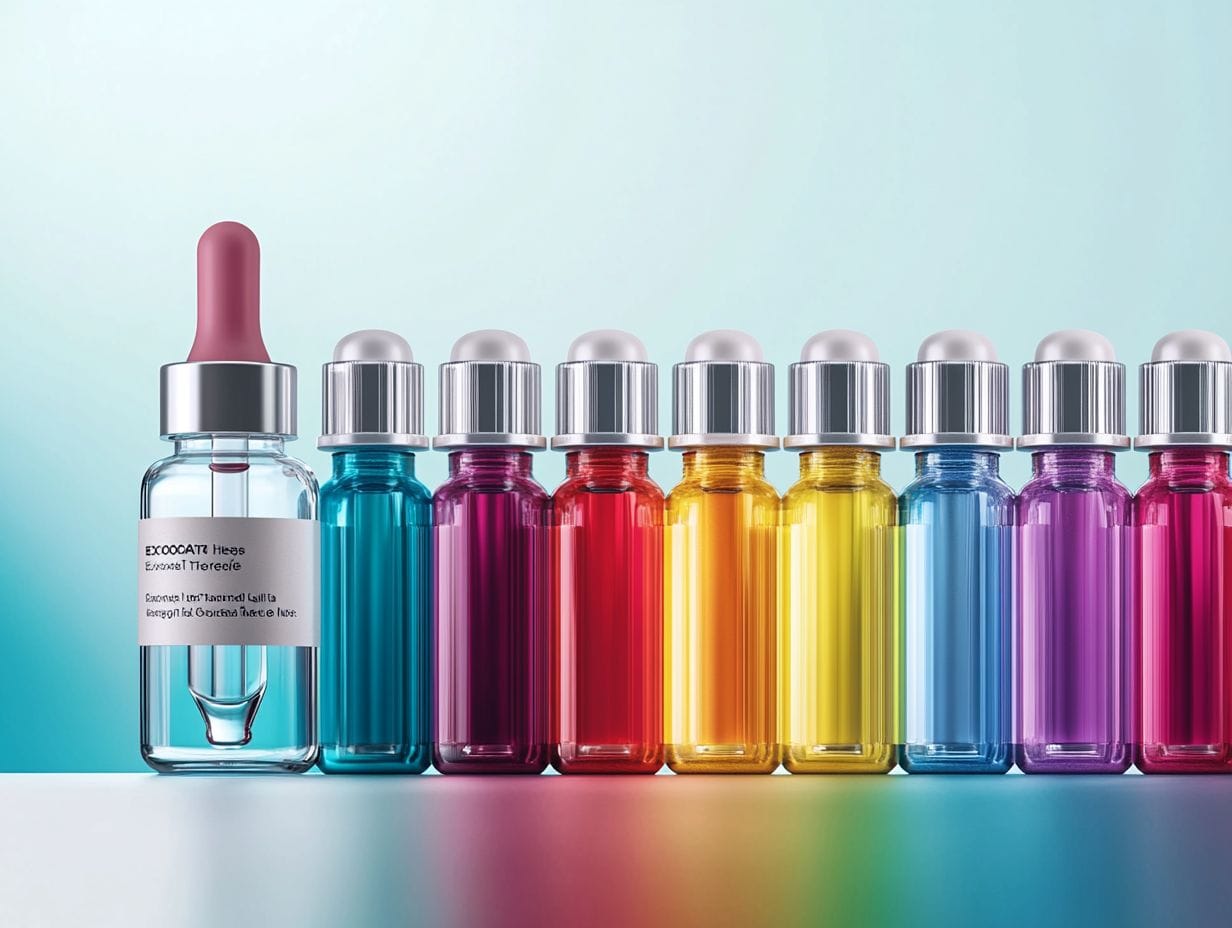Hair loss can be a frustrating and distressing experience, affecting self-esteem and confidence.
With various treatment options available, understanding the causes and types of hair loss is essential before considering solutions.
This article explores two prominent approaches: exosome therapy and hair loss shampoos.
It discusses how each works, their effectiveness, and the pros and cons of both methods.
By the end, you'll be equipped to make an informed decision on the best treatment for your needs.
Understanding Hair Loss

Hair loss is a widespread issue that affects millions of individuals worldwide, resulting in considerable emotional distress and impacting self-esteem. A comprehensive understanding of the complexities surrounding hair loss is essential for the development of effective treatment strategies.
This condition may arise from various factors, including genetic predisposition, hormonal imbalances, and lifestyle choices. Conditions such as androgenetic alopecia are notably prevalent among both men and women.
In addressing hair restoration and growth, it is imperative to consider the diverse demographics of patients and how these factors influence treatment options. Exploring treatments like microneedling vs. mesotherapy can provide insights into which methods may be better for hair growth. By thoroughly examining the causes and types of hair loss, we can better guide individuals towards appropriate solutions tailored to their specific needs.
Causes and Types of Hair Loss
The causes of hair loss are diverse and can be influenced by both genetic and environmental factors, with androgenetic alopecia being one of the predominant types affecting individuals. This condition is characterised by a gradual thinning of hair, often linked to hormonal imbalances and age-related changes.
Additional causes may include inflammation, nutrient absorption issues, and lifestyle factors, all of which contribute to the complex landscape of hair loss. Understanding these underlying causes is essential for effective diagnosis and the development of personalised treatment options, thereby enabling individuals to make informed decisions regarding their hair care regimens. For those weighing their options, exploring minoxidil vs. mesotherapy can provide insights into which may offer better results for hair loss.
For example, inflammation can damage hair follicles, leading to conditions such as alopecia areata, characterised by patchy hair loss. Similarly, nutritional deficiencies particularly of iron and vital vitamins can weaken hair, increasing its susceptibility to shedding.
Lifestyle choices, including stress and poor dietary habits, can further exacerbate these concerns. Implementing preventive measures such as maintaining a balanced diet rich in essential nutrients, engaging in regular physical activity, and practising stress management techniques may significantly reduce the risk of hair loss.
By recognising these underlying factors, individuals can explore various treatment options, including topical solutions and dietary supplements, to effectively support scalp health and promote hair growth. For a deeper understanding, consider reading about minoxidil vs. exosome therapy.
Treatment Options for Hair Loss
The landscape of hair loss treatment options has undergone significant evolution, presenting individuals with a variety of solutions ranging from exosome therapy to conventional topical treatments. Each of these options differs in approach, efficacy, and suitability for various types of hair loss, such as androgenetic alopecia and age-related hair loss.
Innovative therapies have emerged within the field of regenerative medicine, offering the promise of improved patient outcomes without requiring invasive procedures. A comprehensive understanding of the various hair restoration techniques, such as microneedling for female hair restoration, along with their potential benefits and limitations, enables individuals to make informed decisions regarding their hair care strategies.
Overview of Exosome Therapy and Hair Loss Shampoos
Exosome therapy for hair loss represents a cutting-edge advancement in the field of regenerative medicine, utilising the unique properties of exosomes to facilitate hair revitalisation and effectively address hair loss. This cellular therapy enhances scalp health and stimulates hair follicles, making it a compelling option for individuals experiencing hair thinning. In conjunction with exosome therapy, hair loss shampoos infused with therapeutic agents have also gained traction, offering a non-invasive solution to improve hair density and texture. It is essential for individuals considering these options to understand the efficacy of these products through clinical studies and user testimonials.
Exosomes, which are minute vesicles released by cells, play a crucial role in cell communication and regeneration. They transport proteins, lipids, and genetic material, which can significantly influence the behaviour of neighbouring cells, particularly in stimulating hair growth. For women exploring treatment options, understanding exosome therapy vs. topical minoxidil can provide insight into effective hair loss solutions.
Unlike the topical application of hair loss shampoos, which may only penetrate the outer layers of the scalp, exosome therapy delivers active molecules directly to the hair follicles, providing a more targeted and effective approach. While shampoos offer convenience and can serve as a complementary treatment, the deeper biological impact of exosome therapy positions it as a preferred method for comprehensive hair restoration. For a detailed comparison, check out exosome therapy vs. scalp micropigmentation.
How Exosome Therapy Works

Exosome therapy is based on the principle of cellular communication and employs exosomal cargo that is rich in growth factors, cytokines, and other signalling molecules to facilitate hair regrowth. This mechanism of action entails the direct delivery of these therapeutic agents to the scalp, specifically targeting hair follicles and enhancing their microenvironment.
By modulating inflammation and promoting blood circulation, exosome therapy presents a comprehensive approach to hair restoration. To better understand its effectiveness, it is essential to assess its therapeutic efficacy through clinical studies and compare it with traditional treatments.
Mechanism of Action and Potential Benefits
The mechanism of action underlying exosome therapy involves a complex interplay of regenerative medicine and biological signalling pathways, which play a significant role in hair restoration efforts. By delivering growth factors and cytokines directly to hair follicles, this therapy effectively stimulates dormant follicles and promotes hair regrowth.
The potential benefits of exosome therapy extend beyond merely restoring hair; it also addresses critical issues such as inflammation reduction and the enhancement of overall scalp health. The clinical application of this therapy is rapidly expanding, positioning it as a focal point of interest within the fields of dermatology and regenerative medicine.
Several clinical studies have demonstrated its efficacy in comparison to traditional methods, such as topical treatments and hair transplants. Patients who have undergone exosome therapy frequently report quicker results and fewer side effects, which constitutes a significant advantage.
This therapy operates by leveraging the body s inherent healing mechanisms, thus reducing the necessity for invasive procedures. As exosome therapy continues to gain momentum, both practitioners and patients are closely monitoring its long-term effects and potential for further applications in hair regeneration and other medical areas, especially when considering options like hair transplants vs. exosome therapy.
Effectiveness of Hair Loss Shampoos
Hair loss shampoos have become a prominent option for individuals seeking non-invasive solutions for hair restoration, exhibiting varying degrees of effectiveness depending on their formulation and active ingredients.
The efficacy of these shampoos remains a subject of considerable debate, with clinical studies yielding mixed results concerning their capacity to promote hair growth and enhance scalp health.
Key ingredients, including natural extracts and therapeutic agents, significantly influence their effectiveness, while consumer preferences continue to shape the market dynamics. For those exploring their options, understanding the differences between exosome therapy and herbal remedies is essential for making informed decisions regarding hair care products.
Ingredients and Evidence for Efficacy
The ingredients in hair loss shampoos significantly influence their efficacy, with many formulations incorporating growth factors, natural ingredients, and therapeutic agents designed to enhance hair follicle health. Research findings from clinical studies underscore the effectiveness of specific compounds, while user testimonials provide valuable insights into real-world results.
Understanding the role of these ingredients not only informs consumers but also guides product formulation towards achieving optimal outcomes for individuals experiencing hair thinning or loss. As interest in innovative treatments continues to grow, many are exploring options such as microneedling vs. growth factor therapy, and the demand for effective shampoos is on the rise.
Various active ingredients play a crucial role in promoting hair growth, with compounds such as minoxidil and saw palmetto frequently at the forefront. Minoxidil, a well-studied vasodilator, has been scientifically proven to stimulate hair follicles and prolong the hair growth phase. In contrast, saw palmetto functions by inhibiting the hormone responsible for hair loss in many individuals. For women considering further options, exploring hair transplant options may also be beneficial.
[second_cta_shortcode]Additionally, essential oils like rosemary and peppermint have gained recognition for their stimulating effects on scalp circulation. Scientific evidence supports the inclusion of these ingredients, indicating that users may experience thicker, healthier hair. For those exploring options for hair restoration, a comparison of PRP vs. hormonal treatments can provide valuable insights into effectiveness.
Comparing Exosome Therapy and Hair Loss Shampoos

A comparison of exosome therapy and hair loss shampoos highlights a range of treatment options designed to address diverse patient needs and preferences, each with distinct advantages and disadvantages.
Exosome therapy, although more invasive, offers advanced results in hair restoration, while hair loss shampoos present a convenient and non-invasive alternative.
This analysis encompasses patient satisfaction and safety profiles; some individuals may choose the innovative approach of exosome therapy for its regenerative properties, whereas others may favour the simplicity of application associated with shampoos.
Evaluating both options can assist individuals in their quest for effective hair loss treatments.
Pros and Cons of Each Treatment Option
When evaluating the advantages and disadvantages of exosome therapy in comparison to hair loss shampoos, it is imperative to consider the effectiveness of each treatment alongside individual preferences and lifestyle factors.
Patients must assess various elements, including their budget, the level of commitment they can realistically provide, and their desired timeline for results. For example, while exosome therapy typically necessitates multiple sessions with a healthcare professional, it often leads to quicker and potentially more significant hair regrowth. However, this option entails a higher financial cost and a considerable time commitment.
Conversely, hair loss shampoos can be seamlessly incorporated into daily routines and generally offer a more gradual and cost-effective solution. Patient testimonials reveal a spectrum of experiences; some individuals express concerns regarding the effectiveness of shampoos, while others appreciate the convenience and affordability of topical applications.
Striking a balance among these factors is essential for making an informed decision.
Choosing the Right Treatment for You
Selecting the appropriate treatment for hair loss necessitates a thorough evaluation of several factors, including the underlying causes of hair loss, the efficacy of available treatments, and individual preferences.
Engaging with a doctor or a trichologist can offer essential insights into the most suitable options tailored to specific needs, encompassing personalised treatments that take into account patient demographics and lifestyle considerations. Familiarity with contemporary hair restoration techniques, including topical treatments vs. scalp micropigmentation, can further enable individuals to make well-informed decisions in their hair care journey.
Factors to Consider and Consultation with a Doctor
When considering treatment options for hair loss, it is essential to evaluate several key factors, including the severity of the condition, underlying causes, and individual objectives. A consultation with a healthcare professional specialising in dermatology can facilitate the identification of the most effective strategies tailored to an individual's specific needs.
Understanding the importance of patient compliance and adherence to recommended treatment plans is crucial for achieving optimal results. By collaborating closely with a doctor, individuals can effectively navigate the complexities of hair loss treatments and make well-informed decisions regarding their care. For those exploring options, comparing PRP vs. stem cell therapy can provide valuable insights into effective solutions for hair regrowth.
Factors such as age, family history, and overall health play significant roles in determining the most appropriate treatments. Additionally, lifestyle considerations, including diet and stress management, may also influence the outcomes of hair regeneration efforts. For those exploring options, exosome therapy vs. traditional hair transplants offers valuable insights into the best female hair transplant clinics in Birmingham.
It is vital to maintain an open dialogue with the healthcare professional, discussing any previous treatments and medications, as these may impact current options. The potential side effects and the expected timeframe for observing results should be clearly addressed during consultations, especially when considering options like exosome therapy vs. PRP, ensuring a comprehensive understanding of what to anticipate from the selected hair loss solution.
Frequently Asked Questions

What is exosome therapy and how does it work?
Exosome therapy is a cutting-edge treatment for hair loss that involves injecting exosomes, which are tiny extracellular vesicles, into the scalp. These exosomes contain growth factors and other proteins that promote hair growth and repair damaged hair follicles.
How do hair loss shampoos work?
Hair loss shampoos work by cleansing the scalp and hair, removing any buildup of dirt, oil, and product residue. They also contain active ingredients, such as minoxidil or ketoconazole, that are believed to stimulate hair growth and inhibit the production of DHT, a hormone that contributes to hair loss.
Which is more effective for treating hair loss: exosome therapy or hair loss shampoos?
It ultimately depends on the individual and the severity of their hair loss. Exosome therapy tends to be more effective for those with more advanced hair loss or those who have not had success with other treatments. Hair loss shampoos can be effective for milder cases of hair loss, but may not be as effective for more severe cases.
Are there any side effects associated with exosome therapy or hair loss shampoos?
Exosome therapy for hair loss is generally considered safe and does not have any significant side effects. However, some patients may experience mild discomfort at the injection site. Hair loss shampoos may cause scalp irritation or dryness in some individuals, but this is usually temporary and can be mitigated by using a moisturizing conditioner.
Which treatment option is more expensive: exosome therapy or hair loss shampoos?
Exosome therapy is typically more expensive than hair loss shampoos. The cost of exosome therapy can range from several hundred to several thousand dollars per session, while hair loss shampoos can be purchased for less than 50 per bottle. However, the long-term cost of using hair loss shampoos may exceed that of exosome therapy if they do not provide long-lasting results.
Can exosome therapy and hair loss shampoos be used together?
Yes, they can be used together for a more comprehensive approach to treating hair loss. Some doctors may recommend using hair loss shampoos in conjunction with exosome therapy to help maintain the results between treatments. However, it is important to consult with a medical professional before combining any hair loss treatments.


